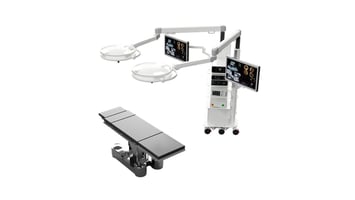Ambulatory Healthcare Design Lab (AHD*lab) seeks to explore innovations in healthcare design and...
Riding the Currents: Designing Wet ORs Safely
According to NFPA 99, the Health Care Facilities Code, operating rooms are to be considered wet locations unless the health care governing body determines through a risk assessment they are not. Surgical procedures involve blood and other bodily fluids, irrigation solutions, as well as other liquids, that can spill onto the floor and create a "wet environment." This can lead to safety hazards for patients and staff including electrical shock, the potential to slip and fall, and infection risks. Special measures must be taken in design to address these challenges.
Electricity and Water Don't Mix
A primary concern in wet ORs is the increased risk of electric shock. The liquids present during surgery can conduct electricity, creating a potentially hazardous situation for both patients and staff. To address these concerns, guidelines and best practices have been established. First, a risk assessment should be conducted to determine if the OR will be a wet area. ASHE, the American Society of Heath Care Engineering, has developed a tool that can help health care facilities make this determination. It can be found at this link: https://www.ashe.org/resources/wetloctool
Isolated Power Systems or GFCI Protection?
Once it has been determined that an operating room will be a wet environment, there are two primary options for design of the electrical system in the room:
- Isolated power systems: These independent electrical systems physically separate the OR's power from the main facility supply, minimizing the risk of shock even if fluids come into contact with electrical components. Line Isolation Monitors, or LIM's, measure the potential of a fault in the system and alert the surgical staff if there is a problem. These systems offer the highest level of protection, though they can be costly and require specialized testing.
- GFCI (Ground Fault Circuit Interrupter) circuit breakers or receptacles: These devices quickly shut off power to a circuit when they detect a current imbalance, potentially caused by a fault. While more affordable than isolated power supplies, GFCIs require regular testing and have limitations in fault detection sensitivity.
Addressing Other Risks:
Beyond electrical safety, design for the wet OR must take other factors into consideration. Here are some key elements:
- Flooring: Provide slip-resistant, non-porous, monolithic flooring with and integral cove base to reduce the risk of slipping, provide for effective cleaning, and improve infection control.
- Wall finishes: Opt for easy-to-clean, water-resistant surfaces that can withstand frequent disinfection.
- Suction: Provide adequate, well-located suction outlets to assist in the removal of liquids during surgery.
- Waste management system: Equipment such as the Neptune Waste Management System can be instrumental in the removal of medical waste and surgical fluids to reduce their accumulation in the operating room.






